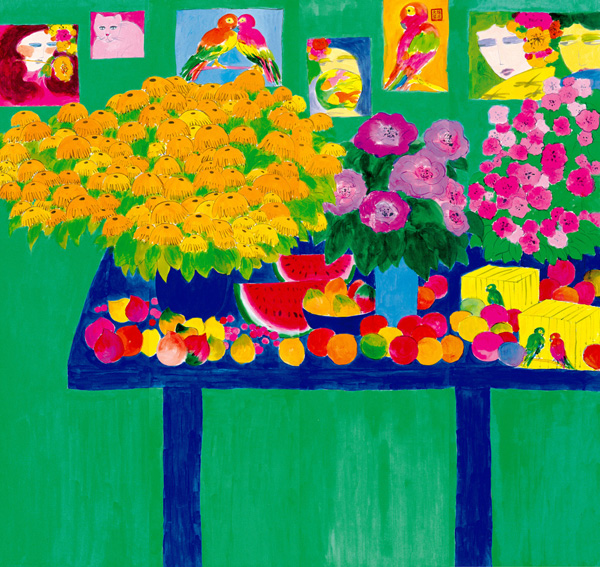|
The Artist's Garden (polyptych)
|
|
Ink and color on paper 180 x 192 cm With one seal of the artist |
|
Estimate
3,200,000 - 5,000,000 761,900 - 1,190,500 97,600 - 152,400
|
|
Sold Price
3,068,000 725,467 92,899
|
|
|
Walasse Ting is a painter and poet. In his delicate and insightful mind, this sensual world is not as superficial as people think. He uses strong and vivid colors in his art works, but it does not mean that his tranquil spirit has been disturbed and got lost in sensual pleasures. Indeed, he loves flowers and women. He appreciates their beauty and delivers his appreciation in his drawings. However, this fascination with beauty is as innocent as his appreciation to mountains. In many people's eyes, his works can be sensual which he makes no efforts to hide, but what people really see is actually his passion toward life.
When staying in Paris, Walasse Ting was attracted and greatly influenced by Henri Matisse's vivid, bright, and contrasting color usage in Fauvism. On the other hand, he was also insipired by the energetic and flexible color dispositions in Chinese folk drawings, which also made him to draw seamless lines freely without any modification. One of the most remarkable features in his works is that the contrasting color dispositions can actually create harmonious images. Moreover, Walasse Ting does not use any specific color to outline different sections in a painting. Instead, outlines are actually shaped from the slim overlaps of the colors of the connected sections in order to create a united and energetic image as a whole.
In "The Artist's Garden", each separate part is the powerful expression of Ting' s fascination: woman, fruit, parrot, and the support of everything – color. These are the elements Ting has spent his whole life on. Unlike other artists who try to purposely organize objects in their paintings, Ting chooses to let all the elements naturally meet each other and let them define and locate themselves. In addition, "The Artist's Garden" also provides us with an opportunity to reappreciate his other works.
Walasse Ting is a well-trained artist with originality. Abandoning the traditional 3-distant painting techniques, he composes his work full of vivid colors without any white space. The whole image with flourishing blossom creating a delicate and fresh atmosphere provides an extremely concrete and powerful expression. Objects in an artist's interpretation and presentation can exceed physical limits and become extraordinary expressions of underlying strong passions, emotions, and feelings.
Walasse Ting is a self-taught artist brought up in Shanghai. Only receiving certain training of Chinese calligraphy and sketch drawing, he has devoted 40 years of his lifetime in this field. As a perceptual artist, he can turn his daily life into the source of his painting materials. He paints his life, so his life can been seen in his paintings. Talking about his painting is like talking about his life. He loves women, so he paints women. He understands women, no matter physically or spiritually. Every stroke is a presentation of Ting's distinct painting style. Women's delicate bodys and internal secrets are revealed on canvas. If lines are an artist's thoughts, colors shall be his feelings. A person with thoughts not necessarily will show his feelings, but if he does, the presentations will be limitless.
Walasse Ting is a person who concentrates on living. Both negative and positive feelings in his daily life can become parts of his innocent enjoyment of life. Materials perceived through his eyes will be combined with emotions and thoughts and then presented in his art works. He is emotional, but his painting style remains consistent.
In Ting's studio, there was no drawing stand or drawing table (if there was, it would be for writing poems and letters). He would put bowls of acrylic colors on a table when drawing on small canvas hung on the wall. He always had to think for a while before he started to paint, but once he made up his mind, he would paint with fast tempo and accurate strokes. Sometimes he was working on several paintings at the same time, but it would only take him one to two hours to complete all the lines, colors, and decorations of all those paintings. He said that there were thousands of woman living in his mind waiting to be drawn anytime. He was drawing not the figures in front of him but the images toward women stored in his mind. After finishing a painting, he would stamp on it cautiously. He had many stamps with special pseudonyms, such as Women Lover, The Happiest Human, Mr. Gallant, Butterfly Gangster, Daily Yearning, and others.
There is a name for each painting, and more or less there are always parrots, fans, crickets, or flowers besides each woman image. There is no male image directly presented in any of his work, but women' s craving for love is clearly expressed. He even said, " Women's beauty is something more than just physical expressions. When I was walking along the street, when I was taking a bus, I am looking at women. I won't stop looking until I go home and start to paint."
